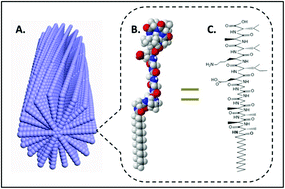当前位置:
X-MOL 学术
›
Biomater. Sci.
›
论文详情
Our official English website, www.x-mol.net, welcomes your
feedback! (Note: you will need to create a separate account there.)
Self-assembly of peptide amphiphiles for drug delivery: the role of peptide primary and secondary structures
Biomaterials Science ( IF 5.8 ) Pub Date : 2017-09-27 00:00:00 , DOI: 10.1039/c7bm00730b Zhenhua Song 1, 2, 3, 4, 5 , Xing Chen 1, 2, 3, 4, 5 , Xinru You 1, 2, 3, 4, 5 , Keqing Huang 1, 2, 3, 4, 5 , Arvind Dhinakar 6, 7, 8 , Zhipeng Gu 1, 2, 3, 4, 5 , Jun Wu 1, 2, 3, 4, 5
Biomaterials Science ( IF 5.8 ) Pub Date : 2017-09-27 00:00:00 , DOI: 10.1039/c7bm00730b Zhenhua Song 1, 2, 3, 4, 5 , Xing Chen 1, 2, 3, 4, 5 , Xinru You 1, 2, 3, 4, 5 , Keqing Huang 1, 2, 3, 4, 5 , Arvind Dhinakar 6, 7, 8 , Zhipeng Gu 1, 2, 3, 4, 5 , Jun Wu 1, 2, 3, 4, 5
Affiliation

|
Peptide amphiphiles (PAs), functionalized with alkyl chains, are capable of self-assembling into various nanostructures. Recently, PAs have been considered as ideal drug carriers due to their good biocompatibility, specific biological functions, and hypotoxicity to normal cells and tissues. Meanwhile, the nanocarriers formed by PAs are able to achieve controlled drug release and enhanced cell uptake in response to the stimulus of the physiological environment or specific biological factors in the location of the lesion. However, the underlying detailed drug delivery mechanism, especially from the aspect of primary and secondary structures of PAs, has not been systematically summarized or discussed. Focusing on the relationship between the primary and secondary structures of PAs and stimuli-responsive drug delivery applications, this review highlights the recent advances, challenges, and opportunities of PA-based functional drug nanocarriers, and their potential pharmaceutical applications are discussed.
中文翻译:

肽两亲物的自组装,用于药物递送:肽一级和二级结构的作用
用烷基链官能化的肽两亲物(PAs)能够自组装成各种纳米结构。近来,由于其良好的生物相容性,特定的生物学功能以及对正常细胞和组织的低毒性,PA被认为是理想的药物载体。同时,由PA形成的纳米载体能够响应于病变部位的生理环境或特定生物学因素的刺激而实现受控的药物释放和增强的细胞摄取。然而,尚未详细总结或讨论潜在的详细药物递送机制,尤其是从PA的一级和二级结构方面。着重于PA的一级和二级结构与刺激反应性药物递送应用之间的关系,
更新日期:2017-11-22
中文翻译:

肽两亲物的自组装,用于药物递送:肽一级和二级结构的作用
用烷基链官能化的肽两亲物(PAs)能够自组装成各种纳米结构。近来,由于其良好的生物相容性,特定的生物学功能以及对正常细胞和组织的低毒性,PA被认为是理想的药物载体。同时,由PA形成的纳米载体能够响应于病变部位的生理环境或特定生物学因素的刺激而实现受控的药物释放和增强的细胞摄取。然而,尚未详细总结或讨论潜在的详细药物递送机制,尤其是从PA的一级和二级结构方面。着重于PA的一级和二级结构与刺激反应性药物递送应用之间的关系,











































 京公网安备 11010802027423号
京公网安备 11010802027423号